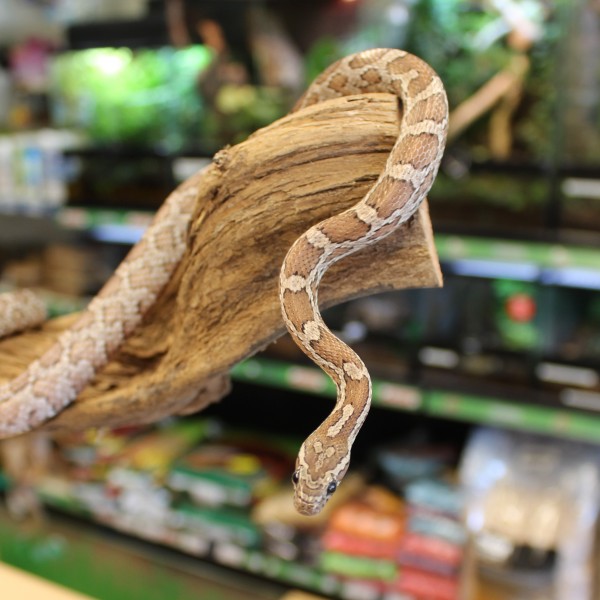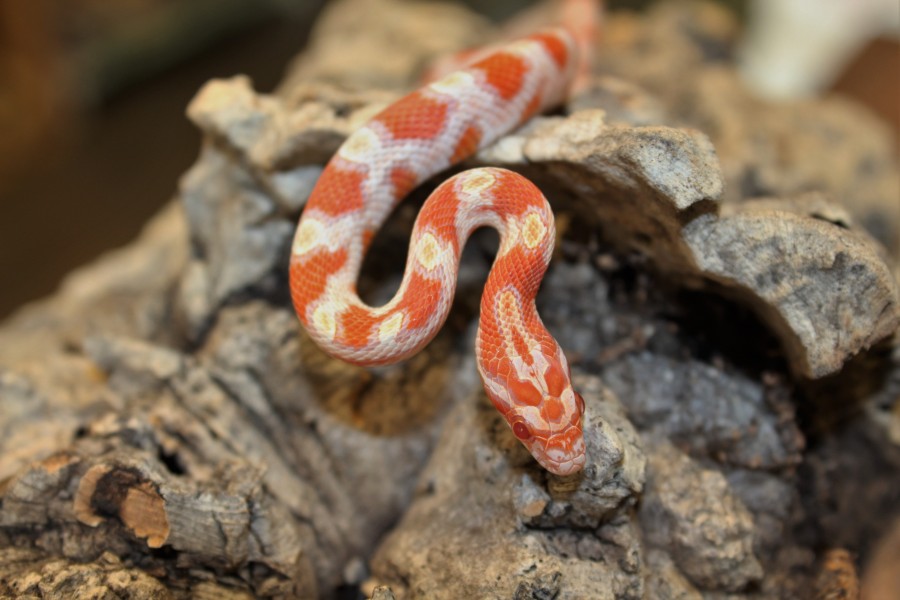Copyright 2021 Evolution Reptiles
All rights reserved.
Copyright 2025 Evolution Reptiles
All rights reserved.
All rights reserved.
The classic pet snake, Corn Snakes (Pantherophis guttatus) are rightly prized for their docile nature, bright colours, ease of feeding and care, and willingness to breed. Found in the wild across the South-eastern United States, from Florida to Southern New Jersey, Louisiana to Kentucky. The wild type – also called Carolina, or Classic – is a reddish brown, slender snake with saddle-like markings along the length of its body, outlined in black. The underside is white with regular black checkerboard markings.

A medium sized snake, they reach an adult size of between 61 and 182cm (24” to 72”, or 2 to 6 feet) although it’s more usual to be roughly in the middle of those sizes. They can be active at any time of the day or night, depending on time of year, day length and temperature; they value plenty of space and items to climb and explore as well as a good choice of secure hides to keep them feeling safe. They can be long lived in captivity, with the average being 12 to 15 years; the record is over 30, but to live well into their twenties is not unusual for a well cared for snake.
Part of their success in captivity is that they are such an adaptable species in the wild. They can be found in woodland, open grassland and meadows, rocky hillsides, urban scrub, around human habitation and even go so far as to move into abandoned buildings and sheds! They are just as eclectic with their diet; although they do eat mostly rodents, they will eat birds, raid nests for eggs and nestlings, take small lizards and even sometimes other snakes. They climb well, and can burrow in loose soil and leaf litter.

As a pet, a corn snake is one of the most straightforward of reptiles to keep. Even small hatchlings are happy to live in an adult sized enclosure as long as there are plenty of baby-sized hides to keep them feeling safe. Piles of loose cork bark are excellent for this, as are half coconut shells and the smaller resin hides. A humid hide filled with moss and kept in the warm end gives the corn snake its own personal sauna in which to curl up when it’s about to shed its skin.
Your corn snake needs a good sized enclosure, preferably 120cm x 60cm x 60cm (4x2x2’). We recommend using a thermostatically controlled deep heat projector mounted at one end with which you control the ambient temperature to give a hot spot to help them digest their food and encourage normal behaviour.
Temperatures should vary between 32ºC (86ºF) at the warm end to 25ºC (77ºF) at the cool end. Directly under the basking spot it can be a little warmer, but no higher than 35ºC. At night the temperature can drop to 20ºC (68ºF), although if it drops slightly lower there is no cause for alarm. Always use a digital thermometer to measure temperature, never guess.
Although it has always been assumed that snakes do not need UV lighting, it is always a good idea to provide it. Low output T5 UV tubes are now available that can mimic the levels of UV that they would be exposed to in the wild, and we have found that when it is provided they will definitely use it.
A variety of different prey items should be offered, sized appropriately for the snake – generally speaking, they can take prey items slightly larger as the largest part of the body. Mice, rats, hamsters, gerbils, chicks – quail and chicken – are all available regularly, and should be used to vary your snakes diet. Corn snakes can be prone to obesity, so keep an eye on your pets weight!
As they eat whole prey items corn snakes do not need any extra calcium or multivitamin supplementation. UVB light has been assumed to be unnecessary, but its presence in a large, well presented vivarium habitat will definitely enhance your pets quality of life.
If you have never kept a snake before then the corn snake is a great species to start with – but be warned, one is never enough!
Common name: Corn Snake, Red Rat Snake
Scientific Name: Pantherophis guttatus
Location: South-eastern United States
Habitat (wild): Varied; deciduous and pine woodland, rocky slopes, meadows, farmland, urban areas
Captive environment: Terrestrial vivarium of 120CM (4’) and over in length, with plenty of hides and areas to explore and climb
Preferred temperature range: daytime hot spot of 32ºC under the basking light, background ambient of 30ºC, cool end of 25ºC. Temperature can drop to 20ºC at night.
Ferguson Zone: Zone 1
UVB Lighting: 5% or 7% UVB strip lamp
Substrate: Wood chip, aspen, lignocel, or soil based
Lifespan: 15 to 20 years, but can be more
Copyright 2021 Evolution Reptiles
All rights reserved.